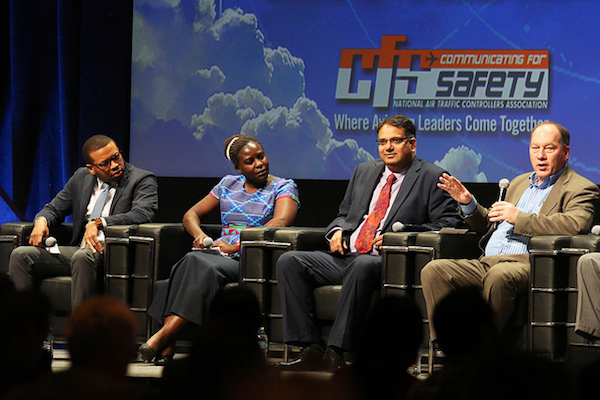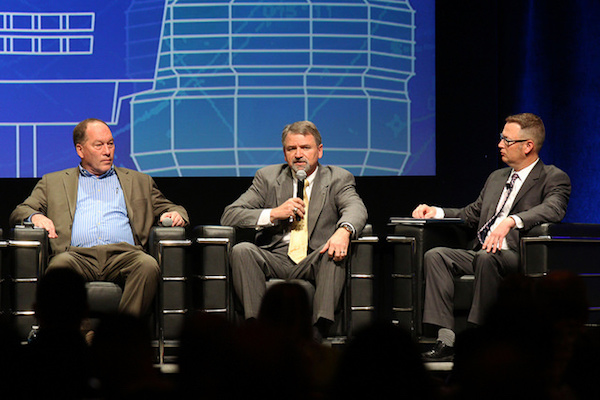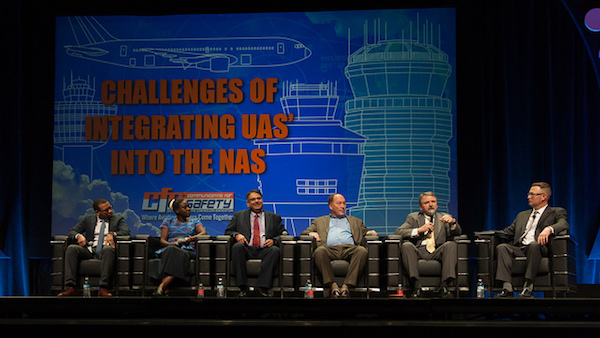
May 20, 2016 // Communicating For Safety 2016 Panel: Challenges of Integrating UAS into the NAS
 |
| From left to right: Mason, Ogutu, Kopardekar, and Pennington. |
Moderator:
Steve Weidner, UAS Rep., NATCA
Panelists:
Marke “Hoot” Gibson, Senior Advisor on UAS Integration, FAA
Steve Pennington, Executive Director, Department of Defense Policy Board, FAA
Parimal Kopardekar, Manager, State Autonomous System Operations, NASA
Keziah Ogutu, Executive Vice President, Africa & Middle East, IFATCA
Travis Mason, Chief of Staff, Google X-Project Wing
Overview:
One of the most exciting and challenging areas in aviation today is the world of Unmanned Aircraft Systems (UAS). In a system as complicated as the National Airspace System (NAS), integrating new technology takes intentional, concerted effort with planning across government, labor, industry, and commercial interest groups.
The diversity of platforms is staggering, ranging from aircraft that will fit in the palm of your hand to aircraft with a wingspan the size of a Boeing 737. As UAS become more widely available, integrating all of these platforms into the NAS presents very unique challenges. The potential of UAS creating unsafe flying conditions is a major concern that led to the FAA Modernization and Reform Act of 2012, which mandated the FAA develop a plan to integrate UAS into the NAS safely.
The panelists represented a wide range of UAS proponents, each bringing a unique perspective on the opportunities and successes in the UAS industry. They also provided a global understanding of the challenges ahead and how best to meet them, as UAS become part of everyday life.
 |
| From left to right: Pennington, Gibson, and Weidner. |
Pennington spoke about the military’s use of UAS, and explained that its priority is ensuring UAS pilots are the best individuals for the job. UAS pilots now comprise the largest community of pilots in the Air Force, and UAS operations are growing rapidly for all sizes of aircraft.
As UAS become more common, Kopardekar said that we “must respect the tradition of safety.” While there are many exciting applications for UAS from security, to photography, to delivery and beyond, we need to enable efficiency and capacity to integrate them into higher altitude airspace safely.
When the United Kingdom’s Remotely Piloted Air System began conducting operations in Kenya, where Ogutu works, they created some confusion for the controllers. Controllers wanted to know how to handle these large UAS. Some of the questions they posed are the essential issues we face with UAS in the United States, such as, “What rules govern these operations?” “What training do pilots and controllers need to manage them?” and “What are the liabilities involved?” IFATCA took up the issue in 2005 and established its position that unmanned aircraft should be in compliance with the same ICAO (International Civil Aviation Organization) standards as manned aircraft.
Mason said Google X’s mission is to solve huge problems with breakthrough technology to find radical solutions. One of them is the inefficiency of ground transportation. Through coordination and collaboration, they hope to keep the public safe while implementing a UAS delivery service. Some of the main ways he hopes to accomplish this are through UAS registration, pilot licensing, cooperation on procedures, collision avoidance, position sharing, and airspace services regulations and policies.
All of the panelists agreed that safety was the number one priority.
Gibson closed the panel by underlining the essential importance of this discussion, “This is the most fundamental change in aviation in our lifetimes. Whatever we do has to be done safely and as a community.”
 |
| From left to right: Mason, Ogutu, Kopardekar, Pennington, Gibson, and Weidner. |

